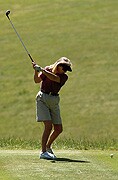
SUNDAY, July 31 (HealthDay News) — Several biomechanical differences appear to separate amateur and professional golfers, researchers find.
Not only could the study identify ways for recreational golfers to hit the ball farther, it could help prevent injuries, said the Stanford University School of Medicine team that conducted the research.
The team used special digital cameras to analyze the full golf swings — from backswing to follow-through — of five amateur and 10 professional male golfers.
The results showed that the swing biomechanics of the pros were highly consistent, and their movements were almost indistinguishable from one another at certain phases of their swings.
The researchers also identified a number of differences between the golf swings of duffers and pros.
“A precise understanding of optimal rotational biomechanics during the golf swing may guide swing modifications to help prevent or aid in the treatment of injury,” the study authors wrote.
“The set of biomechanical factors we examined were selected to capture the essential elements of power generation,” Jessica Rose, associate professor of orthopaedic surgery and senior author of the study, said in a university news release.
Although only men were included in the study, the findings likely apply to women but need examining, Rose said.
The study was published in the July 29 online edition of the Journal of Applied Biomechanics.
More information
The American Academy of Orthopaedic Surgeons outlines ways to prevent golf injuries.

